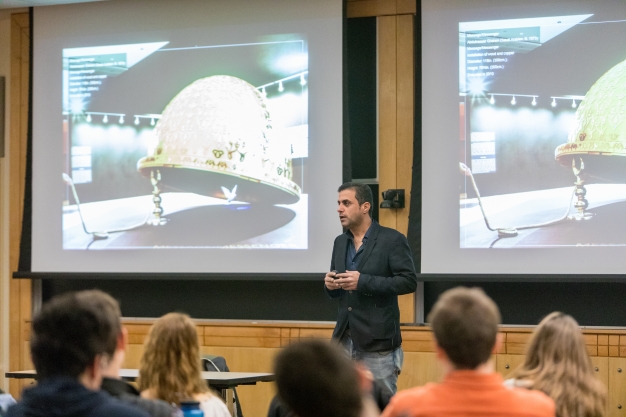
As part of the programming surrounding Phantom Punch: Contemporary Art from Saudi Arabia in Lewiston, noted Saudi Arabian artist Abdulnasser Gharem lectured on his work.
Abdulnasser is recognized as one of the most influential Saudi Arabian artists today. He is an artist and until retiring in 2014, a Lieutenant Colonel in the Saudi Army.
Abdulnasser is a conceptual artist who operates over a multitude of fields including photography, video, performance and sculpture. His work challenges the perception of art and visual culture in his native Saudi Arabia. His seminal work Siraat (The Path) (on view in Phantom Punch) was a controversial clarion call for social action and engagement with both personal and shared histories. In a four-day, meditative performance, he and his colleagues covered the buttress of a destroyed bridge thousands of times with the word “siraat” in memory of the tragic collapse of the bridge during a flood in a mountainous valley below the city of Abha in the southwest of the Kingdom. Although many people died, the incident was never reported in Saudi newspapers. Abdulnasser highlights the significant role that official censorship in the Saudi media has had in shaping social realities as understood by Saudis themselves. The Path was subsequently censored from an exhibition, an unintended performance of the way official narratives continue to shape public awareness of national history. From this point on, Abdulnasser began to incorporate thousands of rubber stamps into his work in order to protest the ease with which official institutions construct and enforce binding codes and practices.
King Abdulaziz Center for World Culture, known as ithra, is a one-of-a-kind institution that brings together multiple offerings under one roof. From arts and culture to science and innovation, this bold initiative by Saudi Aramco promises a continuous journey of enrichment designed to energize the next knowledge economy of Saudi Arabia.
ithra aims to make a positive and tangible impact on the cultural scene by focusing on building local talents in the knowledge and creative industries. Blending iconic architectural design with advanced technology, and unique learning methods with enriching programs, ithra is an infinitely inspiring platform for explorers, learners, creators, and leaders–a thriving hub of knowledge, creativity and cross-cultural engagement.
As the Kingdom of Saudi Arabia strives to achieve its ambitious national development goals to transition to a knowledge-based economy, ithra acts as a bridge connecting cultures and cultivating a creative and innovative community.
As a teaching museum at a liberal arts college, the Museum of Art and its exhibitions, collections, stewardship, and interpretation bring a world of ideas to campus that enhance the vitality of the intellectual and cultural life of Bates, the surrounding communities, and beyond. The museum serves as a laboratory for the development and presentation of thought-provoking exhibitions; acquires and stewards artworks that strengthen the collection in ways that support the liberal arts curriculum; develops a wide variety of education programs that are integral to Bates and the broader community, especially K-12 students; supports creative, rigorous, and original scholarship; and provides professional training opportunities through internships. The Bates Museum of Art is recognized for presenting ambitious and adventuresome thematic exhibitions of regional, national, and international artists, and for integrating them into the academic and cultural life of campus, the surrounding communities, and the state of Maine.
Visit our Facebook Page
Follow us on Twitter
Follow us on Instagram
Visit our Youtube Channel
Visit our Tumblr profile
Visit our Instagram profile
×